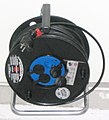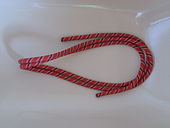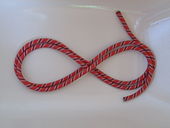Shooting up a line
The shooting of a line is understood in the sailor's language to be the folding of ropes ("lines") in loops ("trips") in order to stow it as a "wish" so that it is ready for use at any time. This term is also used for rope in mountain sports .
sense
Raised lines on a nail bank
Lines in the form of a Flemish disc safely on deck
Leashes are ready for use at any time when they are raised. In this way, they can be stowed safely without loosening again in rough seas . This is particularly important for throw lines that have to be ready for immediate use in an emergency, as well as for traps that have to be thrown at any time.
Shooting prevents the lines from getting mixed up ("getting unclear" or forming a wuling ), lines lying around hindering work, being a source of accidents, falling overboard and being lost or damaged. Even with lines that are tied on one side, the other end should never fall overboard, as the salt water can affect the lifespan of the rope. In addition, there is a considerable risk that the line could get caught in the ship's propeller, rendering the boat unable to maneuver.
On the other hand, pods are never shot open during sporty sailing, as they are constantly in use when trimming sails. With mooring lines, the rest of the rope is always shot up on board the ship (not at the jetty).
application
Shoot the leash
The line is laid in rolls of equal length. With light ropes, the shooting can be done over the arm, the same length is created by the same arm span. When the rope is to be stowed away, a round turn is placed around the resulting bundle and a second one over it, pinching the first one (and one to three more if necessary). The end of the rope is then pulled through the big eye as a bay and the bay is pulled over the head of the bundle and tightened.
Alpine rope puppet

It is important that the rolls are laid cleanly. Because if they were twisted, they would get caught when throwing. Long and twisted ("twisted") lines are first run completely through the hand before shooting in order to eliminate twisting, so-called "kinks".
If a line is in use and the remaining rope is to be shot up, shooting up is always started at the fixed end of the rope so that all the curls can be worked out towards the loose end of the rope. The round trips are also made with the fixed end, which is then pulled as a loop through the eye on the bag and used for hanging.
In harvested (.. D h of several strands [strands] twisted) rope is to be noted the rotational direction: right laid rope is coiled up in the clockwise direction to the left harvested counterclockwise. This avoids untwisting the rope into its individual cardels. The direction of rotation is irrelevant with braided cordage.
Shoot the case
Lines, on a document nail or a mast cleat are occupied (in particular traps are) not bound together. The neatly laid bays are secured with a head blow. To do this, a piece of the fixed end of the rope is pulled through the bays as a loop from the back to the front, the loop is twisted twice and placed over the upper part of the belaying nail or the upper cleat horn. Such a secured request can be thrown off at any time.
- Occupying a cleat
Shoot the cable
Even with cables , folding is called "shooting up". Long cables are best wound on reels. Cables with a length of 5 to 20 meters, for example microphone cables in stage technology , are shot up as eight (8). This ensures that the cable does not twist when it is unwound. This is particularly important so that the individual wires inside and the wire-braided shielding do not twist when the cables are laid out and are protected from permanent damage. Cables are usually tied together with Velcro .
Decent shooting up
By shooting up, which includes a twisting process, the line is twisted in on itself.
Beautiful bays
In order for the line to lie smoothly and tidily, it must be turned continuously when shooting. Experienced seafarers do this automatically with a small movement of the hand. With long lines, however, this is increasingly difficult if the end cannot rotate freely. However, it is not a problem if the rope is stretched out through the water or can hang freely when climbing. Very long lines (mooring lines, anchor ropes) are laid in large rings on the deck and sometimes piled up in real towers. Neat lanky linen fly when throwing without vertörnen itself. They are always ready for use even after lying for a long time. If the leash cannot twist out while stretching, then it helps to let it run through your hand first.
Twisted
If you shoot up the line without compensating for the twists, there is a risk that the loops will shift into one another in such a way that loops will form when they are loosened and knot into one another. This is almost always the case when throwing. If stored for a long time, this twist becomes permanent and hinders the use of the rope.
Twisted as "8"
The line can be shot open as a double loop, as an "eight". It can be grabbed in the middle so that both circles hang down. However, this method can cause problems when the ropes are laid because one circle of each figure eight loop is twisted in the "wrong" direction. This method is not widespread in seafaring for braided cordage either. When climbing, the rope is sometimes folded like this. It's then twisted in two directions and when it's stretched it's straight again. But here, too, there is a risk that the individual bays will become knotted together. Climbers therefore use a rope bag into which the stretched rope is placed and pulled out again for use.






















